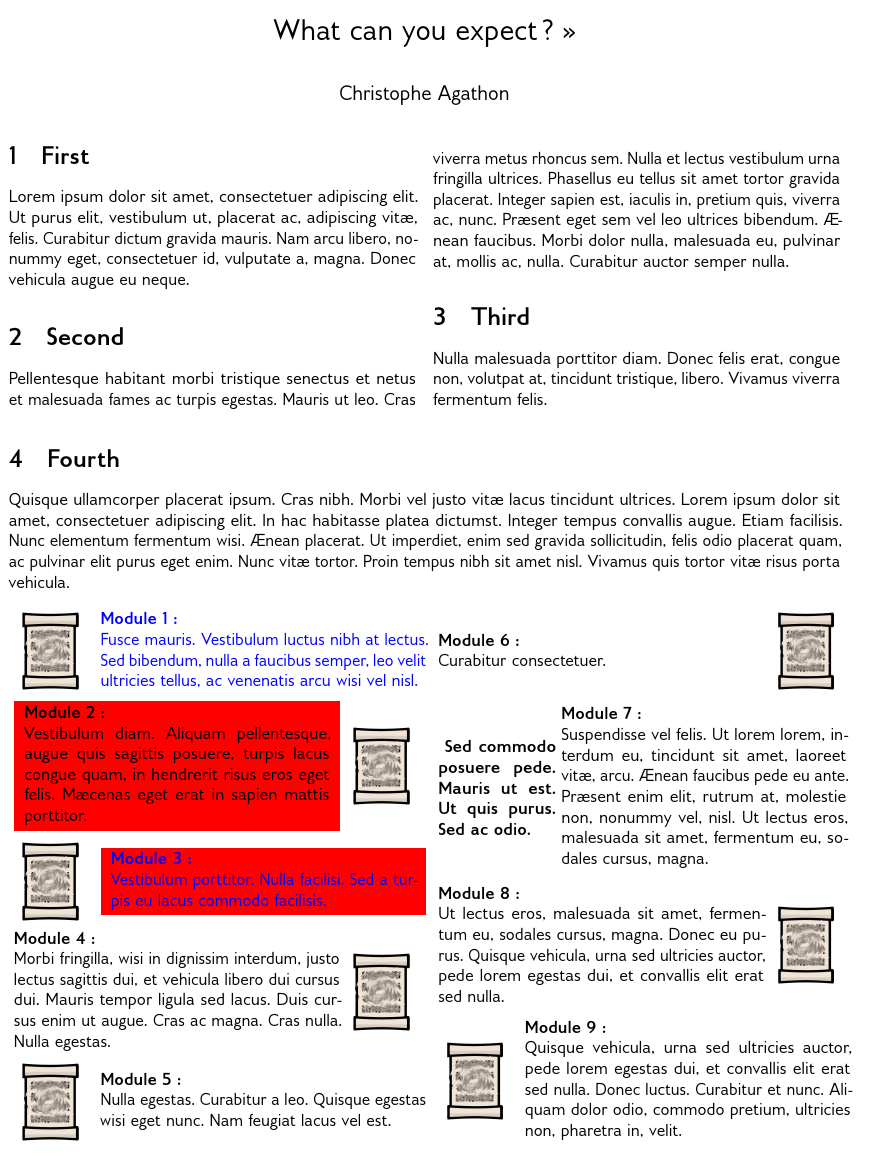Column Div
Columns and other things with Pandoc’s markdown
This Lua filter for Pandoc improves Pandoc’s Div usage.Especially fenced divs witten in Pandocs markdown.
v1.0. Copyright: © 2021 Christophe Agathon christophe.agathon@gmail.com License: MIT - see LICENSE file for details.
Introduction
Pandoc fenced divs can be very powerful allowing providing, in theory many document formating possibilities. Unfortunately, plain Panfoc processing doesn’t make full advantage of it and discards some formatting in HTML outputs and most of it in Latex outputs.
Multiple columns in document are only partialy accessible in Beamer (not plain Latex) and HTML outputs.
As a result, it’s not possible to render fancy multi columns PDF document from markdown sources.
The main purpose of this filter is to make it possible and give similar formatting features for both Latex/PDF and HTML outputs.
My guidelines are :
1) Use Pandoc divs like many already have proposed for uneven and even columns 2) Same functionalities and rendering in HTML and Latex+PDF 3) Mess the least possible with plain Pandoc processing which is quite OK already for HTML (miss only column-count for even columning). 4) Allow users to use unknown Latex environments from exotic packages if they wish, provided they include them in the preamble.
Usage
Basic usage
Copy column-div.lua in your document folder or in your pandoc
data directory (details in
Pandoc’s manual).
Run it on your document with a --luafilter option:
pandoc --luafilter column-div.lua SOURCE.md -o OUTPUT.pdf
or specify it in a defaults file (details in Pandoc’s manual).
This will generate consistent HTML, Latex and PDF outputs from Pandoc markdown files.
Formating the document
Everything is done with Pandoc’s fenced divs with class names and attributes. The attributes are similar to those from HTML styling and/or Latex.
Multiple even columns
For Latex and PDF output, you will need to call the multicol package. This can be done un the YAML header.
Example:
---
header-includes:
- |
```{=latex}
\usepackage{multicol}
```
---
Some regular text
:::: {.multicols column-count="2"}
Some text formatted on 2 columns
::::
- Latex output is done with
multicolsenvironment. - HTML output uses
style="column-count: 2"on a div block.
Uneven columns
No specific Latex package are needed. We use Nested Pandoc divs in the same way that columns and column environments are used in Latex.
Example:
:::::::: {.columns}
:::: {.column width="20%" valign="c"}
Some text or image using 20% of the page width.
::::
:::: {.column width="80%" valign="c"}
Some text or image using 80% of the page with.
::::
::::::::
- Latex (and PDF) rendering use minipage environments
- HTML rendering is not affected by this filter since Pandoc do it
well already (based on divs with
widthattributes).
Other usages
For HTML outputs, you already can create divs with whatever class names you
like and style them with style=" … " attributes. This is
processed by Pandoc and has nothing to do with this filter.
This filter allows to do the same in Latex (and PDF).
You can create whatever environment you need. The environment name is the
class name given to the fenced div. In case of multiple class names, the
first one is used. Other are ignored but allowed to help you to maintain
a single markdown source for PDF and HTML outputs.
The data-latex=" … " attribute allows you to pass options and
parameters to the \begin environment instruction.
Complicated layout in PDF or HTML
You can achieve complicated multicolumn layout with text images and colors by using only Pandoc’s Markdown fenced divs as shown below:

Here is the md source file.
To Do
Others multi column features could be implemented as column spacing, rules, etc.
Since Pandoc does a very good job with the width styling
attribute to implement variable column width, it could easily
support HTML even column via the column-count attribute.
Contributing
PRs welcome.